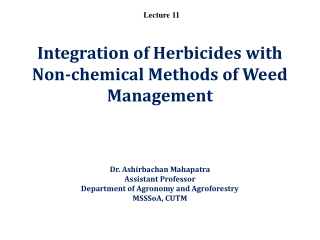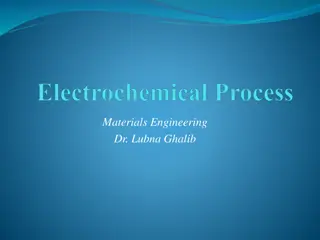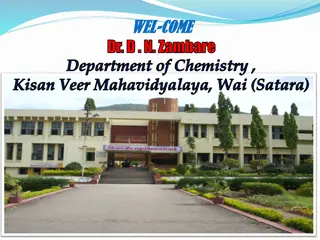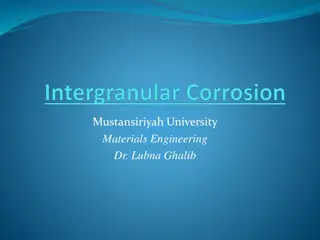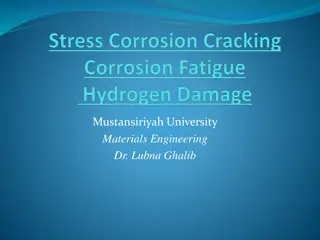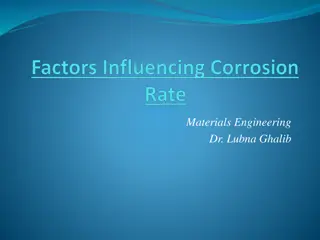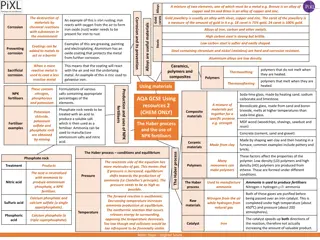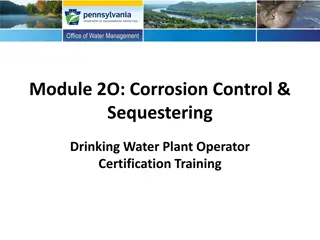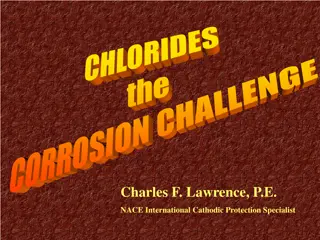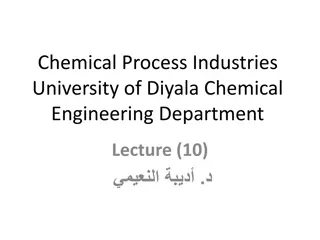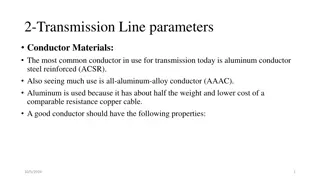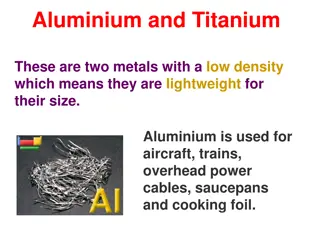Corrosion Prevention Methods in Chemical Engineering
Define oxidation, reduction, oxidizing agent, reducing agent, standard electrode potential, Nernst equation, and corrosion in the context of chemical engineering. Discuss different forms of corrosion, including uniform corrosion, galvanic corrosion, pitting corrosion, and stress corrosion. Explore methods for corrosion prevention such as environmental modifications, metal selection, cathodic protection, corrosion inhibitors, coating, and plating. Explain cathodic protection methods using sacrificial anodes and impressed current protection, and the importance of corrosion inhibitors. Test your knowledge with multiple-choice questions on electrochemical cells and corrosion prevention techniques.
Download Presentation

Please find below an Image/Link to download the presentation.
The content on the website is provided AS IS for your information and personal use only. It may not be sold, licensed, or shared on other websites without obtaining consent from the author.If you encounter any issues during the download, it is possible that the publisher has removed the file from their server.
You are allowed to download the files provided on this website for personal or commercial use, subject to the condition that they are used lawfully. All files are the property of their respective owners.
The content on the website is provided AS IS for your information and personal use only. It may not be sold, licensed, or shared on other websites without obtaining consent from the author.
E N D
Presentation Transcript
MCQ ENGINEERING CHEMISTRY Chemical Engineering Department Made by: Eng. Chapter 5
Summary I. Define 1-Oxidation : loss of electron (s) by a species. 2- reduction : gain of electron(s). 3- oxidizing agent : Oxidizing Agent causes oxidation & is reduced. 4- reducing agent : Reducing Agent causes reduction & is oxidized. 5- Estandard electrode potential ( ? ) : it is the electrode potential measured at 1 M solution concentration and 1cm and all gases are at 1atm at ?? C. 6- Nernst equation: 7- Corrosion : the transformation of a metal from elemental to the combined state.
Summary II. Discuss A-Explain different corrosion forms? 1- Uniform corrosion (general corrosion) - The most common type - Due to chemical or electrochemical reaction - Happen over the surface of metal 2-Galvanic corrosion - happen between two metal contacts with each other - Metal with less potential is the anode (corrode), the metal with higher potential is the cathode - Like cupper with iron. 3- Pitting corrosion - Very dangerous and grows with the gravity - Like all metals subjected to high velocity liquids, cupper and brass tubes 4-Stress corrosion - its the growth of crack formation in a corrosive environment. - This form of corrosion is particularly dangerous because it may not occur under a particular set of conditions until there is an applied stress.
Summary State different methods for corrosion prevention? 1-Environmental Modifications 2-Metal Selection and Surface Conditions 3-Cathodic Protection 4-Corrosion Inhibitors 5-Coating 6-Plating
Explain different methods of cathodic protection? 1-sacrificial anode, uses metal anodes, introduced to the electrolytic environment, to sacrifice themselves (corrode) in order to protect the cathode. 2-impressed current protection. What is the importance of corrosion inhibitor? Inhibitors can work by adsorbing themselves on the metal's surface and forming a protective film.The inhibitors process is slowing corrosion process
Choose the correct answer: 1- in an electrolytic cell the electrode at which the electrons enter the solution is called the __ ; the chemical change that occurs at this electrode is called ___. (a) anode, oxidation (b) anode, reduction (c) cathode, oxidation (d) cathode, reduction (e) cannot tell unless we know the species being oxidized and reduced. Answer d
Choose the correct answer: 2- Which of the following methods is not used for the prevention of corrosion? a) greasing b) painting c) plating d) Heating Answer: b
Choose the correct answer: 3- Corrosion can be prevented by a) alloying b) tinning c) galvanizing d) all of the above Answer: (d)
Choose the correct answer: 4- Galvanic cells are also named as: a) electrolytic cells b) battery cells c) daniel cells d) john cells Answer: a Explanation: Galvanic cells, also known as voltaic cells, are electrochemical cells in which spontaneous oxidation-reduction reactions produce electrical energy.
Choose the correct answer: 5- Galvanization is a method to a) protect the iron metal from corrosion b) extract iron from its ore c) protect food from rancidity d) improve the ductility property of the metal Answer: a Explanation: Galvanisation is a method of protecting iron and steel from rusting by coating them with zinc.
Choose the correct answer: 6- Corrosion between the dissimilar metals is called as ____ a) Galvanic corrosion b) Dry corrosion c) Oxidation corrosion d) Concentration cell corrosion Answer: a Explanation: Corrosion between the dissimilar metals is called as the galvanic corrosion. Dry corrosion also called as the chemical corrosion.
Choose the correct answer: 7- Corrosion due to the formation of cavities around the metal is called as the _____ a) Pitting corrosion b) Soil corrosion c) Water line corrosion d) Galvanic corrosion Answer: a Explanation: Corrosion due to the formation of cavities around the metal is called as the pitting corrosion. Corrosion between the dissimiliar metals is called galvanic corrosion.
Choose the correct answer: 8- electrochemical interaction of the metal with its environment is called _____: a) Electrolysis b) Electrodialysis c) Corrosion d) Deposition The process of deterioration of a metal due to unwanted chemical or Answer: c Explanation: The process of deterioration of a metal due to unwanted chemical or electrochemical interaction of the metal with its environment is called corrosion. It is a natural process, which converts a refined metal to a more stable form, such as its oxide, hydroxide, or sulfide.
Choose the correct answer: 9- On anode __ reaction occurs : a) Oxidation b) Reduction c) Redox d) None of above Answer: a Explanation: cathode is reduction. The reaction at the anode is oxidation and that at the
Choose the correct answer: 10- In Redox Reaction, electrons may be a) Gained only b) Lost only c) Shared d) Gained and lost Answer: d
Choose the correct answer: 11- Electrochemical cell is achieved by connecting two a) ions b) electrodes c) half cell d) non of above ANSWER: c
Choose the correct answer: 12- Electromotive force is equal to a) E cathode E anode b) E anode E cathode C) E - ? ANSWER: a
13- A galvanic cell with a measured standard cell potential of 0.27 V is constructed using two beakers connected by a salt bridge. One beaker contains a strip of gallium metal immersed in a 1 M solution of GaCl3, and the other contains a piece of nickel immersed in a 1 M solution of NiCl2. The half-reactions that occur when the compartments are connected are as follows: cathode: Ni2+(aq) + 2e Ni(s) anode: Ga(s) Ga3+(aq) + 3e If the potential for the oxidation of Ga to Ga3+is 0.55 V under standard conditions, what is the potential for the oxidation of Ni to Ni2+? a) E cathode= 0.28 V b) E cathode= 0.46 V c) E anode= 0.28 V Answer: a Explanation: A We have been given the potential for the oxidation of Ga to Ga3+under standard conditions, but to report the standard electrode potential, we must reverse the sign. For the reduction reaction Ga3+(aq) + 3e Ga(s), E anode= 0.55 V.. E cell= E cathode E anode 0.27 V = E cathode ( 0.55 V) E cathode= 0.28 V
Choose the correct answer: 14- The following electrochemical cell is made: Cu(s)|Cu2+(aq, 0.1 M)||I (aq, 0.1 M)|I2(s)|C(s) The cell potential was measured and found to be 0.279 V. Calculate E cell a ) 0.321 V b) 0.290 V c ) 0.190 V ANSWER: c Explanation: Ecell = E cell (0.0592/2)log{[Cu2+][I ]2} or E cell = Ecell + (0.0592/2)log{[Cu2+][I ]2} = 0.279 V + (0.0592/2)log(0.1)3 E cell = 0.279 V 0.0888 V = 0.190 V
THANK YOU Any questions?


